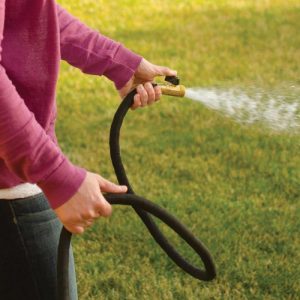As much as we like to see your smiling faces and are happy to book you a spring/fall service and maintenance call, we think it is important to give our customers the tips and tricks to save you time and money. Here are some easy instructions for caring for your Awnings & Screens.
AWNINGS
Motorized Retractable Awnings
**In the beginning of the season, always check your GFCI breaker and reset it before you try to operate the awning.
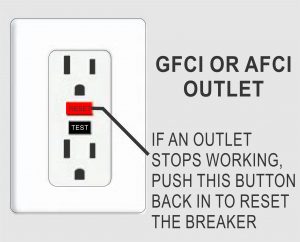
Look for any GFCI or AFCI outlet that has been triggered – these outlets have “Test” and “Reset” button and often just pushing the “Reset” button will work.
If power is not restored, call Artistic Awning & Screens for advice or to schedule a service appointment.
Awning remote:
When you press the button and the red light is on- the batteries are fine. If the light does not go on you need to replace the batteries.
Tools required: Mini Phillips screwdriver and new battery. The battery needed is a 3V DL 2430 Duracell+ battery (see photo) you can purchase at a local London Drugs.
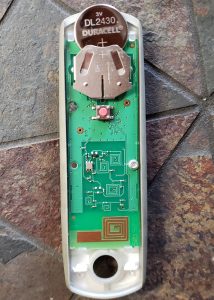
Remove the backing of the remote using your mini phillips screwdriver, take note on what side of the battery is face up before removing it. Replace old battery with new.
Press the down arrow button to ensure remote is working before putting the backing of the remote case on.
Wind Sensor:
Batteries should be changed once a year at the beginning of the year.
Tools required: small flat head screw driver and 2 AAA batteries
Your wind sensor is located on the front profile bar of your awning, it will be located on the same side your motor is on. To remove the wind sensor, lightly tap it to the left- if you are unsure, the front of the wind sensor shows picture images of what side is lock and what side is unlock. Once removed, flip the device over and pop out the grey backing with your flat head screw driver.
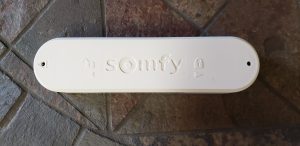
Please take note of the direction of the batteries as the wind sensors go against everything you have ever been taught about what way batteries should go in. Pop the grey backing back onto the sensor and slide the wind sensor back in to the base going in from the right. The awning will not work without the wind sensor attached to the base correctly.
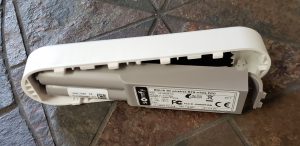
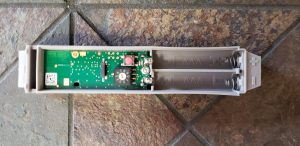
Manually Operated Retractable Awnings & Fixed Frame Awnings
Lubrication:
Although it is not necessary, the awning hardware (moving parts) may be lubricated once a year. A lithium grease spray lubricant can be used if gears are really stiff and hard to operate. Apply a very small amount of lubricant on the pitch adjust bushing to maintain optimal, smooth operation. After application make sure you crank the pitch up and down to spread the lubrication throughout the threading.
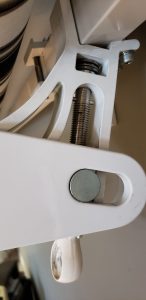
***Avoid spraying any lubricant on the fabric.
Acrylic & Vinyl Fabric Cleaning:
What does proper fabric cleaning involve? Not much at all! The main objective is to keep as much dirt and grime off the fabric as possible.
The fabric can be cleaned without removing it from the frame.
Brush off, with a clean soft household broom any loose soil. Hose down (do not use a pressure washer- a simple gentle garden hose is sufficient) your awning fabric (top and bottom) with clean water. We recommend you do this on a hot dry day in order for the fabric to completely air dry before retracting it. We suggest cleaning the awning at least twice each year, in the spring after pollen has spread and again in the fall after the leaves have fallen. Do not use harsh or strong detergents (use woolite or dawn dish soap) or scrub too vigorously with a cleaner. Never dry the fabric using heat or a steam press. Keep shrubbery and vines away from the system, as many plants contain acids that can be harmful to the fabric.
- Brush off loose dirt
- Hose down
- Prepare a cleaning solution of water and mild soap such as Woolite or Dawn dishwashing liquid
- Use a soft bristle brush to clean
- Allow cleaning solution to soak into the fabric
- Rinse thoroughly until all soap residue is removed
- Air dry
Frame Cleaning and Maintenance:
The frames are all made of non-corrosive materials. We recommend that you wipe down the frame and all moving parts with a damp rag- soap is not necessary.
Miscellaneous:
The valance on your retractable awning is a separate piece of fabric. Because it is more exposed to the elements you may wish to remove it during the winter. Simply remove the end cap from the front rail and slide the fabric and spline off. To avoid creasing the fabric simply remove the spline and store the fabric rolled up rather than folded. Be sure to place it in a dry, well ventilated area away from rodents. A concrete floor is not an ideal place. Never store in a plastic bag, this can trap moisture and promote mildew.
SCREENS
Motorized Retractable Screens
**In the beginning of the season, always check your GFCI breaker and reset it before you try to operate the screen.

Look for any GFCI or AFCI outlet that has been triggered – these outlets have “Test” and “Reset” button and often just pushing the “Reset” button will work.
If power is not restored, call Artistic Awning & Screens for advice or to schedule a service appointment.
Remote:
If you press the button and the blue lights under the bottom arrow light up- the battery is fine. If the light does not go on, you need to change the battery.
To change the battery, flip the remote over and slide the bottom part of the remote off. You will need a CR2450 RoSHCELL 3V lithium cell battery. Replace the old battery with the new one and make sure the blue light on the front of the battery comes on before you replace the backing of the remote.
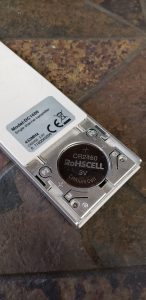
Rail Lubrication:
Roll the screen up into the cassette, use a silicone spray and spray for one second from the top of the rails to the middle of the rails on both sides. Run the screen up and down multiple times so the silicone spray spreads throughout the gasket and up and down the rails.
Cleaning the cassette and rails:
Take a damp cloth and wipe away any dirt, dust and residue left behind from the winter months.
Cleaning the screen:
Take a garden hose and rinse off the screen when it is in a down position, keep it down until it is dry. If there is anything left behind after hosing down the screen (dirt clumps or bird waste) take a soft finger brush and gently scrub the dirty area- do not press too hard.
